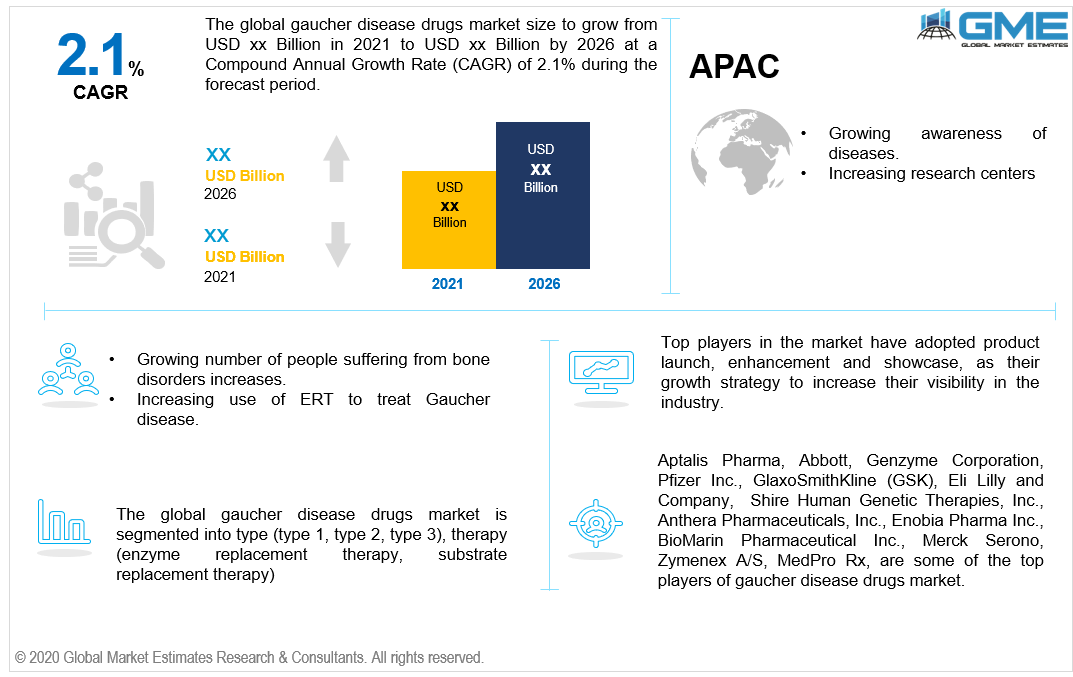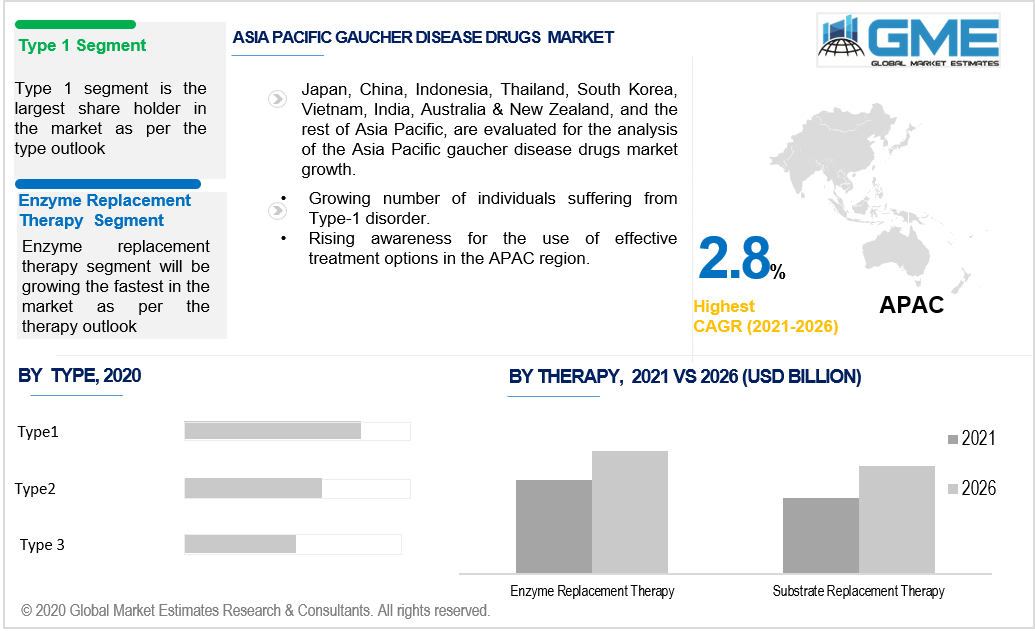
Global Gaucher Disease Drugs Market Size, Trends, and Analysis - Forecasts To 2026 By Type (Type 1, Type 2, Type 3), By Therapy (Enzyme Replacement Therapy, Substrate Replacement Therapy) By Region (North America, Asia Pacific, CSA, Europe, and the Middle East and Africa); End-User Landscape, Company Market Share Analysis & Competitor Analysis
Gaucher disease/disorder is a hereditary and genetic disorder in which fatty molecules build up in the cells or tissues. Constant fatigue, a swollen spleen, anemia, liver, and skin bruising, and a reduced blood cholesterol level are all common symptoms of genetic disorders. Gaucher disease is caused by the lack of the enzyme glucocerebrosidase. Since the deficiency is genetic, children are more susceptible than adults. Gaucher disorder is caused by a shortage in the glucocerebrosidase enzyme, which leads to an excess of glucosylceramide, mainly in white blood cells and macrophages. Since macrophages are unable to remove the fatty material, it tends to accumulate. The fat grows up in the liver, spleen, kidneys, brain, lungs, and bone marrow. Gaucher disease patients experience a wide range of signs or symptoms.
In the past, most patients were given recombinant enzyme imiglucerase. The therapy was successful in reducing Gaucher disease's hematologic and visceral symptoms. However, the enzyme is relatively responsive to slow skeletal disease response and pulmonary intervention. Treatment of Gaucher disorders is usually given once a week in a high dosage, but in certain situations, a medium dose of a drug is given once a week or 3 days in a low dose amount. Both types of dosage treatments have shown significant responses.
However, the boost in the number of patients globally seems to contribute to the enlargement of Gaucher disorder care in the industry over the forthcoming years, the shortage of treatments in the final stages of production is expected to hinder the Gaucher disorder industry's development. Patients with stage 1 Gaucher disorder who have anemia, thrombocytopenia, or a bone deficiency should consider ERT. Similarly, the severity of the condition and its rate of development vary, particularly in adults, complicating the medical specialist's care decision. Enzyme replacement treatment has significantly increased the patients' standard of living. Profit margins have risen for companies that use enzymes. As a result, the key companies in the sector are focusing their efforts on developing the most up-to-date drug treatment for people with gaucher disease. Gaucher disorder has a lower prevalence than other terminal illnesses, so treatment is more expensive and progress is gradual.
Increased emphasis on forming rare disease research alliances is contributing to an increase in disease awareness and monitoring. Besides that, increasing access to critical healthcare facilities is largely leading to disease testing and detection at an early level. The emergence of symptomatic control solutions, and also their validation in foreign investment groups and governing bodies, has led to increased symptom control solutions accessibility.

Based on the type, the Gaucher disease drug market is divided into Type 1, Type 2, and Type 3. Because of the rising number of cases worldwide, the Type I Gaucher disease category is expected to hold a substantial share of the Gaucher disorder market. Anemia-related symptoms, bleeding tendency, visceral problems, and overall well-being are all short-term treatment goals for Type I. Furthermore, treating respiratory problems is one of the long-term treatment targets for Type I disease. Factors like the proper patient and family education about the disease and treatment will aid in the efficient implementation of Type I Gaucher disorder.
Types 2 & 3 disorder are very rare. All of these diseases are neuronopathic, which means they cause CNS symptoms as they develop. Owing to the lack of care and the intensity of disease development, type 2 GD infants rarely live for over two years.
Based on allergy therapy, the Gaucher disease drugs market can be divided into Enzyme Replacement Therapy, and Substrate Replacement Therapy. During the forecast period, the Enzyme replacement therapy section is expected to grow at the fastest rate. The growing use of ERT for curing Gaucher disorder around the world, and also increasing awareness of its use, are driving this treatment. Similarly, the ERT's greater proportion of FDA-approved medicines would lead to the section's growth.

As per the geographical analysis, the market can be classified into North America, Asia Pacific, Europe, Middle East & Africa, and Central & South America. North America leads the global demand for gauche disease care because of its high diagnosis rate and a vast number of enzyme replacement therapy facilities.
Furthermore, the Asia-Pacific region is likely to rise at an exponential rate in terms of CAGR throughout the expected timeframe. Japan is expected to rise the fastest due to growing disposable income, increased disease awareness, and the high unmet medical needs of patients.
Aptalis Pharma, Abbott Laboratories, Genzyme Corporation, Pfizer Inc., GlaxoSmithKline (GSK), Eli Lilly and Company, AVROBIO, Shire Human Genetic Therapies, Inc., Anthera Pharmaceuticals, Inc., Enobia Pharma Inc., BioMarin Pharmaceutical Inc., Merck Serono, Zymenex A/S, and MedPro Rx, among others are some of the top players of Gaucher disease drugs market.
Please note: This is not an exhaustive list of companies profiled in the report.
Chapter 1 Methodology
1.1 Market Scope & Definitions
1.2 Estimates & Forecast Calculation
1.3 Historical Data Overview and Validation
1.4 Data Sources
1.4.1 Secondary
1.4.2 Primary
Chapter 2 Report Outlook
2.1 Global Gaucher Disease Drugs Industry Overview, 2019-2026
2.1.1 Industry Overview
2.1.2 Product Overview
2.1.3 Type Overview
2.1.4 Regional Overview
Chapter 3 Gaucher Disease Drugs Market Trends
3.1 Market Segmentation
3.2 Industry Background, 2019-2026
3.3 Market Key Trends
3.3.1 Positive Trends
3.3.1.1 Increasing investments in research & development activities
3.3.1.2 Increasing adoption of type 1 treatment
3.3.2 Industry Challenges
3.3.2.1 High cost associated with implementation of predictive analysis
3.4 Prospective Growth Scenario
3.5 COVID-19 Influence over Industry Growth
3.6 Porter’s Analysis
3.7 PESTEL Analysis
3.7 Value Chain & Supply Chain Analysis
3.9 Regulatory Framework
3.9.1 North America
3.9.2 Europe
3.9.3 APAC
3.9.4 LATAM
3.9.5 MEA
3.10 Technology Overview
3.11 Market Share Analysis, 2020
3.11.1 Company Positioning Overview, 2020
Chapter 4 Gaucher Disease Drugs Market, By Type
4.1 Type Outlook
4.2 Type 1
4.2.1 Market Size, By Region, 2019-2026 (USD Million)
4.3 Type 2
4.3.1 Market Size, By Region, 2019-2026 (USD Million)
4.4 Type 3
4.3.1 Market Size, By Region, 2019-2026 (USD Million)
Chapter 5 Gaucher Disease Drugs Market, By Therapy
5.1 Therapy Outlook
5.2 Enzyme Replacement Therapy
5.2.1 Market Size, By Region, 2019-2026 (USD Million)
5.3 Substrate Replacement Therapy
5.3.1 Market Size, By Region, 2019-2026 (USD Million)
Chapter 6 Gaucher Disease Drugs Market, By Region
6.1 Regional outlook
6.2 North America
6.2.1 Market Size, By Country 2019-2026 (USD Million)
6.2.2 Market Size, By Type, 2019-2026 (USD Million)
6.2.3 Market Size, By Therapy, 2019-2026 (USD Million)
6.2.4 U.S.
6.2.4.1 Market Size, By Type, 2019-2026 (USD Million)
6.2.4.2 Market Size, By Therapy, 2019-2026 (USD Million)
6.2.5 Canada
6.2.5.1 Market Size, By Type, 2019-2026 (USD Million)
6.2.5.2 Market Size, By Therapy, 2019-2026 (USD Million)
6.3 Europe
6.3.1 Market Size, By Country 2019-2026 (USD Million)
6.3.2 Market Size, By Type, 2019-2026 (USD Million)
6.3.3 Market Size, By Therapy, 2019-2026 (USD Million)
6.3.4 Germany
6.3.4.1 Market Size, By Type, 2019-2026 (USD Million)
6.2.4.2 Market Size, By End-Use, 2019-2026 (USD Million)
6.3.5 UK
6.3.5.1 Market Size, By Type, 2019-2026 (USD Million)
6.3.5.2 Market Size, By End-Use, 2019-2026 (USD Million)
6.3.6 France
6.3.6.1 Market Size, By Type, 2019-2026 (USD Million)
6.3.6.2 Market Size, By Therapy, 2019-2026 (USD Million)
6.3.7 Italy
6.3.7.1 Market Size, By Type, 2019-2026 (USD Million)
6.3.7.2 Market Size, By Therapy, 2019-2026 (USD Million)
6.3.8 Spain
6.3.8.1 Market Size, By Type, 2019-2026 (USD Million)
6.3.8.2 Market Size, By Therapy, 2019-2026 (USD Million)
6.3.9 Russia
6.3.9.1 Market Size, By Type, 2019-2026 (USD Million)
6.3.9.2 Market Size, By Therapy, 2019-2026 (USD Million)
6.4 Asia Pacific
6.4.1 Market Size, By Country 2019-2026 (USD Million)
6.4.2 Market Size, By Type, 2019-2026 (USD Million)
6.4.3 Market Size, By Therapy, 2019-2026 (USD Million)
6.4.4 China
6.4.4.1 Market Size, By Type, 2019-2026 (USD Million)
6.4.4.2 Market Size, By Therapy, 2019-2026 (USD Million)
6.4.5 India
6.4.5.1 Market Size, By Type, 2019-2026 (USD Million)
6.4.5.2 Market Size, By Therapy, 2019-2026 (USD Million)
6.4.6 Japan
6.4.6.1 Market Size, By Type, 2019-2026 (USD Million)
6.4.6.2 Market Size, By Therapy, 2019-2026 (USD Million)
6.4.7 Australia
6.4.7.1 Market Size, By Type, 2019-2026 (USD Million)
6.4.7.2 Market size, By Therapy, 2019-2026 (USD Million)
6.4.8 South Korea
6.4.8.1 Market Size, By Type, 2019-2026 (USD Million)
6.4.8.2 Market Size, By Therapy, 2019-2026 (USD Million)
6.5 Latin America
6.5.1 Market Size, By Country 2019-2026 (USD Million)
6.5.2 Market Size, By Type, 2019-2026 (USD Million)
6.5.3 Market Size, By Therapy, 2019-2026 (USD Million)
6.5.4 Brazil
6.5.4.1 Market Size, By Type, 2019-2026 (USD Million)
6.5.4.2 Market Size, By Therapy, 2019-2026 (USD Million)
6.5.5 Mexico
6.5.5.1 Market Size, By Type, 2019-2026 (USD Million)
6.5.5.2 Market Size, By Therapy, 2019-2026 (USD Million)
6.5.6 Argentina
6.5.6.1 Market Size, By Type, 2019-2026 (USD Million)
6.5.6.2 Market Size, By Therapy, 2019-2026 (USD Million)
6.6 MEA
6.6.1 Market Size, By Country 2019-2026 (USD Million)
6.6.2 Market Size, By Type, 2019-2026 (USD Million)
6.6.3 Market Size, By Therapy, 2019-2026 (USD Million)
6.6.4 Saudi Arabia
6.6.4.1 Market Size, By Type, 2019-2026 (USD Million)
6.6.4.2 Market Size, By Therapy, 2019-2026 (USD Million)
6.6.5 UAE
6.6.5.1 Market Size, By Type, 2019-2026 (USD Million)
6.6.5.2 Market Size, By Therapy, 2019-2026 (USD Million)
6.6.6 South Africa
6.6.6.1 Market Size, By Type, 2019-2026 (USD Million)
6.6.6.2 Market Size, By End-Use, 2019-2026 (USD Million)
Chapter 7 Company Landscape
7.1 Competitive Analysis, 2020
7.2 Sanofi Genzyme
7.2.1 Company Overview
7.2.2 Financial Analysis
7.2.3 Strategic Positioning
7.2.4 Info-Graphic Analysis
7.3 Shire Therapeutics
7.3.1 Company Overview
7.3.2 Financial Analysis
7.3.3 Strategic Positioning
7.3.4 Info-Graphic Analysis
7.4 Pfizer
7.4.1 Company Overview
7.4.2 Financial Analysis
7.4.3 Strategic Positioning
7.4.4 Info-Graphic Analysis
7.5 Johnson & Johnson
7.5.1 Company Overview
7.5.2 Financial Analysis
7.5.3 Strategic Positioning
7.5.4 Info-Graphic Analysis
7.6 Dong-A-Socio Holdings
7.6.1 Company Overview
7.6.2 Financial Analysis
7.6.3 Strategic Positioning
7.6.4 Info-Graphic Analysis
7.7 JCR Pharmaceuticals,
7.7.1 Company Overview
7.7.2 Financial Analysis
7.7.3 Strategic Positioning
7.7.4 Info-Graphic Analysis
7.8 GSK
7.8.1 Company Overview
7.8.2 Financial Analysis
7.8.3 Strategic Positioning
7.8.4 Info-Graphic Analysis
7.9 Eli Lilly and Company
7.9.1 Company Overview
7.9.2 Financial Analysis
7.9.3 Strategic Positioning
7.9.4 Info-Graphic Analysis
7.10 Anthera Pharmaceuticals, Inc.
7.10.1 Company Overview
7.10.2 Financial Analysis
7.10.3 Strategic Positioning
7.10.4 Info-Graphic Analysis
7.11 Merck Serono
7.11.1 Company Overview
7.11.2 Financial Analysis
7.11.3 Strategic Positioning
7.11.4 Info-Graphic Analysis
7.12 Other Companies
7.12.1 Company Overview
7.12.2 Financial Analysis
7.12.3 Strategic Positioning
7.12.4 Info-Graphic Analysis
The Global Gaucher Disease Drugs Market has been studied from the year 2019 till 2026. However, the CAGR provided in the report is from the year 2021 to 2026. The research methodology involved three stages: Desk research, Primary research, and Analysis & Output from the entire research process.

The desk research involved a robust background study which meant referring to paid and unpaid databases to understand the market dynamics; mapping contracts from press releases; identifying the key players in the market, studying their product portfolio, competition level, annual reports/SEC filings & investor presentations; and learning the demand and supply-side analysis for the Gaucher Disease Drugs Market.

The primary research activity included telephonic conversations with more than 50 tier 1 industry consultants, distributors, and end-use product manufacturers.

Finally, based on the above thorough research process, an in-depth analysis was carried out considering the following aspects: market attractiveness, current & future market trends, market share analysis, SWOT analysis of the company and customer analytics.

Frequently Asked Questions
Tailor made solutions just for you
80% of our clients seek made-to-order reports. How do you want us to tailor yours?
OUR CLIENTS